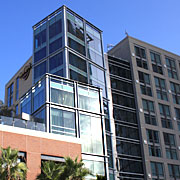Curtain Walls
We set the stage for form and function.Curtain wall is a term used to describe a building façade which does not carry any dead load from the building other than its own, and which transfers the horizontal loads (wind loads) that are incident upon it. These loads are transferred to the main building structure through connections at floors or columns of the building. A curtain wall is designed to resist air and water infiltration, wind forces, seismic forces (usually only those imposed by the inertia of the curtain wall), and its own dead load forces.
Curtain walls differ from storefront systems in that they are designed to span multiple floors, and consider design requirements such as: thermal expansion and contraction, building sway and movement, water diversion, and thermal efficiency for cost-effective heating, cooling, and lighting.
Types of Curtain Wall Systems:
- Stick systems
The vast majority of curtain walls are long pieces (referred to as sticks) installed vertically between floors and horizontally between vertical members. Framing members may be fabricated in a shop environment, but all installation and glazing is typically performed at the jobsite. - Unitized systems
Unitized curtain walls entail factory fabrication and assembly of panels and may include factory glazing. These completed units are hung on the building structure to form the building enclosure. Advantages include: speed, lower field installation costs, and quality control within an interior climate controlled environment. The economic benefits are typically realized on large projects or in areas of high field labor rates. - Rainscreen Principle / Pressure Equalization (A more common term)
A common feature in curtain wall systems, the Rainscreen Principle theorizes that equilibrium of air pressure between the outside and inside of the "rainscreen" prevents water penetration into the building itself. For example, the glass is captured between an inner and an outer gasket in a space called the glazing rebate. The glazing rebate is ventilated to the exterior so that the pressure on the inner and outer sides of the exterior gasket is the same. When the pressure is equal across this gasket, water cannot be drawn through joints or defects in the gasket.
Featured Projects
Hard Rock HotelCenter for the Reproduction of Endangered Species
Discovery Corporate Center
CSU San Marcos School of Business
Civic View
National City Library
Scripps Northridge
L.A. Southwest College
Ferring Pharmaceuticals
Escondido Lexus









